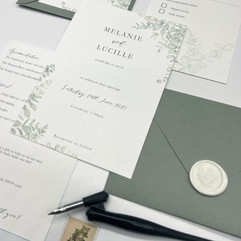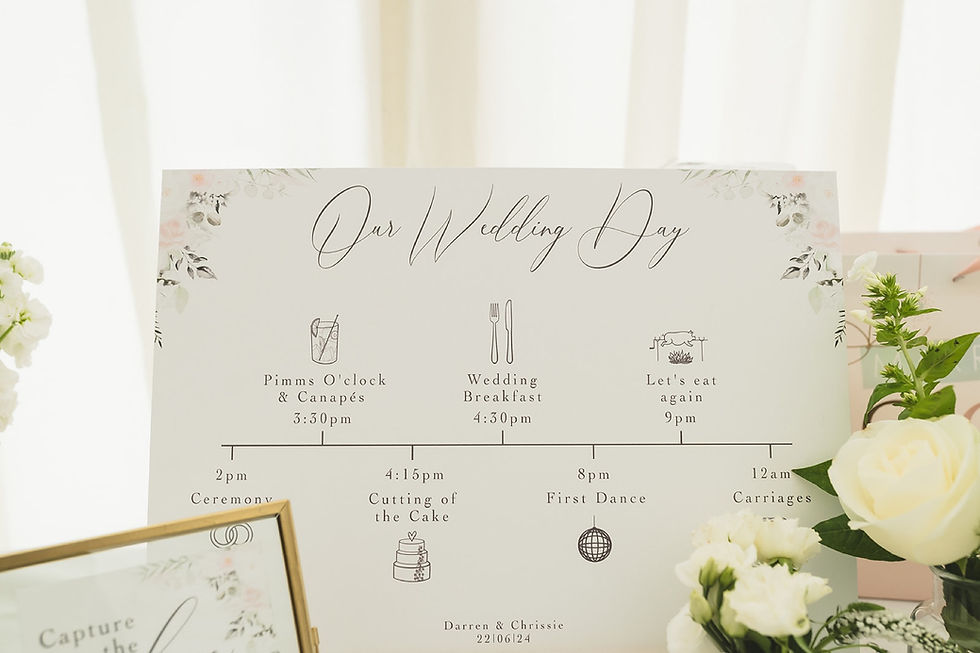Wording Wisdom: Your Guide to Wedding Invitation Etiquette for Every Family Situation
- huntergatherings
- 5 days ago
- 4 min read
Before we launch into this potential minefield of a topic, I want to give you hope!
There is a wedding invitation out there, worded to perfection to suit you as a couple and the celebration you want to hold, and that acknowledges who is supporting you in doing it. It can be done, no matter how intricate your situation is.
And for more good news, you don’t need to start from scratch; there is a wealth of tradition and etiquette to draw on, developed over centuries of couples facing the same dilemmas as you are right now. Your wedding invite needs to work hard for you, and understanding the established etiquette will give you a good start. The final wording, however, is always yours to choose – so feel free to adapt and mould whatever you see here until it’s the best fit for you as a couple.

Setting the tone
An invitation is an announcement of a special event, and every event needs a host. They are the ones who do the planning, send the invites, pay what needs to be paid, and make sure everyone is taken care of on the day. It’s a big role, and traditionally it was the sole responsibility of the bride's family. Thankfully, times have changed, and the couple getting married now has much more autonomy over the whole process. Often taking on the role of hosting and settling the bills themselves, with their family's support. Your invitation is an important opportunity for you to acknowledge who is contributing to your wedding and to let your guests know as well.
So, the two key questions you need to ask yourself before designing your invitations are:
1. Who is hosting your wedding?
2. What tone are you aiming for?
1) Announcing the host is how you would traditionally start your invitation. Who is requesting their presence? This is where it can get tricky: the host could be multiple people – you, as a couple, either parent (s), both sets of parents, divorced parents, a blended family, or a mix of all the above. There are many good reasons to tread carefully with your wording, and I have lots of examples of how to handle this sensitively.
2) The formality of the words you choose to announce your host also plays a key role. It’s important to find the right level of formality for the wedding you’re planning. "Request the honour of your presence" would suit a black-tie event, whereas "invite you to celebrate" is more relaxed for a barn wedding.
Here’s how it can be done!
Section 1: The Classic Scenarios (Married Parents Hosting)

Wording Tip: For a traditional look, remember to spell out all dates and times (e.g., Saturday, the twenty-fifth of May, two thousand and twenty-four, at five o'clock in the evening). Modern invites use numerals (e.g., Saturday, May 25, 2024, at 5:00 PM).
Pro Tip: Use "honour of your presence" for a religious ceremony (house of worship) and "pleasure of your company" for a secular ceremony.

Section 2: When the Couple is the Host
This is the most common modern scenario, simplifying the process by placing the focus squarely on the couple.

Wording Tip: Using "Together with their families" is a gracious way to acknowledge parental support without getting into the specifics of who paid for what.

Section 3: Navigating Divorced and Blended Families
This requires the most sensitivity. The key is to list the hosts by their current relationship status and level of involvement/contribution, with a new line for each separate hosting party.
Key Etiquette Rules for Divorced Parents:
1. Separate Lines: Divorced parents' names never appear on the same line. A new line indicates they are separate hosts.
2. Order: Traditionally, the mother's name is listed first, unless the father is the primary host/contributor.
3. Stepparents: A stepparent who is married to a hosting parent is included on the same line as their spouse, but should be listed only if they are involved in the couple's life and wedding planning.

Sensitivity Tip: If your parents' relationships are complex or strained, the "Together with their families" option is a safe, diplomatic, and modern solution that avoids prioritising one host over another.
For my final etiquette nugget, let’s look at how to include the names of your guests.
• Formal – the names of your guests do not appear on the printed invitation itself. Instead, they should be written on the envelope.
• Informal – here, the guest’s name can be incorporated into the main invitation. For example: Emily and Michael request the pleasure of [guest’s name(s)] to join them in celebrating their marriage.
I hope this has helped you navigate the intricacies of invitation wording.
It can be a lot! But whether you're going for traditional or modern, hosting solo or with an entire clan, these are just guidelines, I also have a handy guide that you'll recieve when it comes to filling out your wording form when you've booked me, to make it even easier.
I'm always on hand to chat through options, you can see various examples from previous clients on my website and instagram or pop me an enquiry to book in a call to get the journey started—I would love to help.
Love Fran xxx















Comments